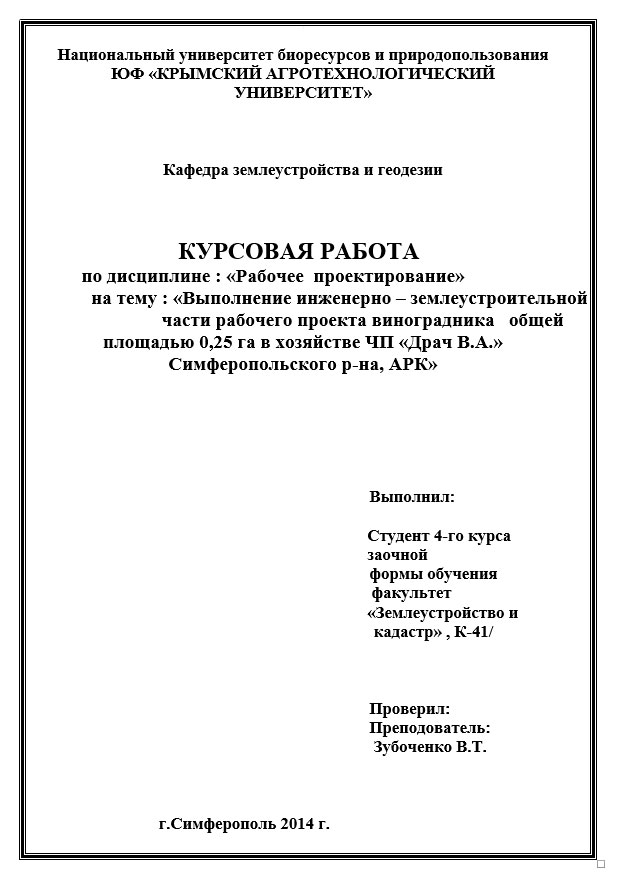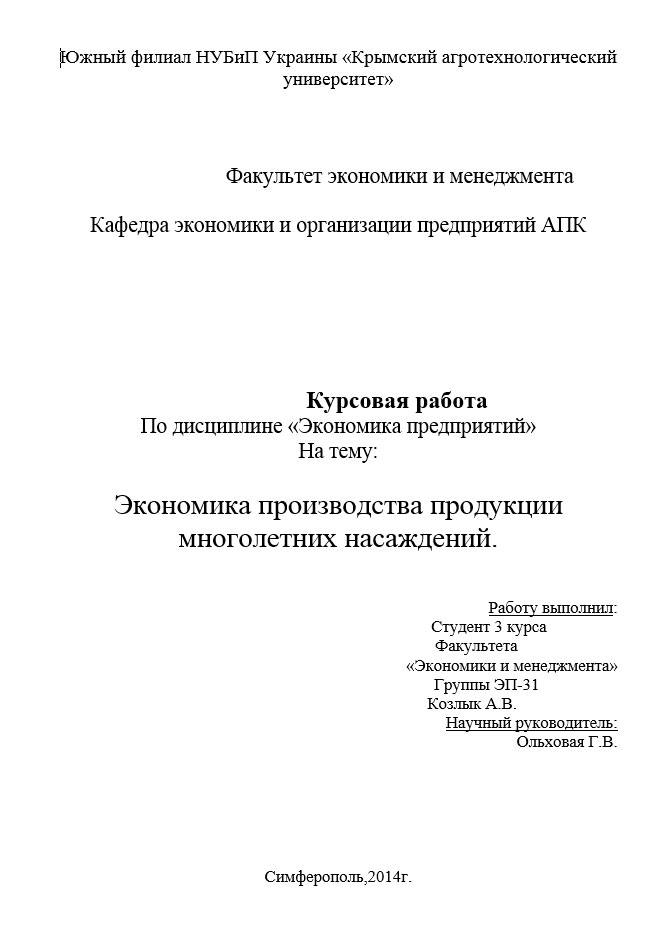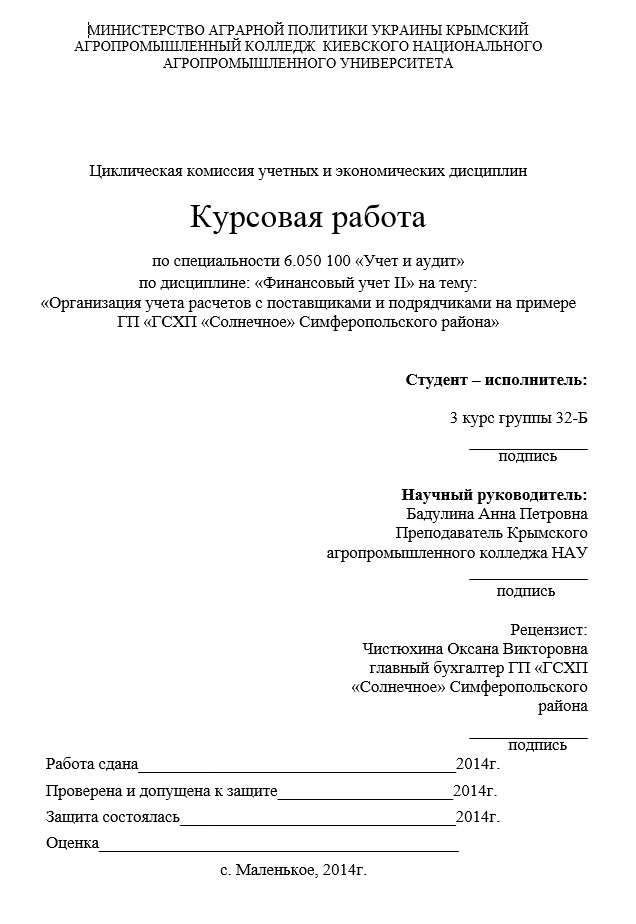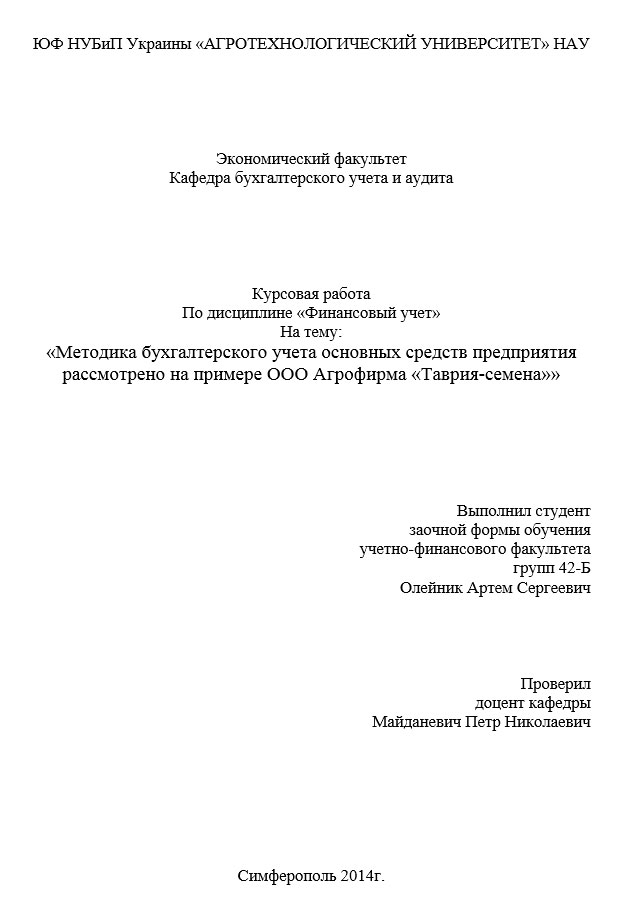Download title page. The title page of the course work is a sample.
REQUIREMENTS FOR THE CONTENT AND REGISTRATION OF THE ABSTRACT An abstract is a concise record of ideas contained in one or more sources, which requires the ability to compare and analyze different points of view. An abstract is one of the forms of interpretation of a source text or multiple sources. Therefore, the abstract, in contrast to the synopsis, is a new, author's text. The novelty in this case implies a new presentation, systematization of the material, a special author's position when comparing different points of view. STRUCTURE OF THE ABSTRACT 1. Title page (drawn up in accordance with the Appendix) 2. Table of contents (contents) with page numbers for each section of the abstract 3. Introduction 4. The main part, consisting of chapters 5. Conclusion 6. Sources (list of used literature and Internet sources) The introduction explains: why such a topic was chosen, why it is important (personal attitude to the topic (problem), how it is relevant (the attitude of modern society to this topic (problem)), what cultural or scientific value it represents (from the point of view of researchers, scientists); what literature is used: research, popular science literature, educational, who are the authors ... ("The material for writing the abstract served ..."); what the abstract consists of: introduction, number of chapters, conclusion, appendices ("The introduction shows the idea (purpose) Chapter 1 is devoted to ..., in Chapter 2 ... In the conclusion, the main conclusions are formulated ... "). The main part of the abstract consists of several sections, gradually revealing the topic. Each of the sections is considered as any of the sides of the main topic. Assertions of positions are supported by evidence taken from the literature (citation, indication of numbers, facts, definitions). If the evidence is borrowed from the author of the literature used, then they are drawn up as links to the source and have a serial number. Links are written at the bottom of the text under the line, where the serial number of the link and the data of the book or article are indicated. At the end of each section of the main part, a conclusion must be formulated. (“Thus, .. We can conclude that ... As a result, we can come to a conclusion ...”) In the conclusion (very briefly) general conclusions on the main topic, prospects for the development of research, our own view of solving the problem and the position of the authors of the literature used, about their agreement or disagreement with them. RULES FOR PREPARING THE ABSTRACT 1. The abstract must be printed on a standard A4 sheet of writing paper in compliance with the following requirements: margins: left 3 cm, right 1.5 cm, top 2 cm, bottom 2 cm; typeface: Times New Roman; font size: for the main text 14; line spacing: 1.15; first line indent: 1.25 cm; text alignment: by width. 2. The text is printed lowercase lettersexcept for the first capital letter. 3. Pages are numbered with Arabic numerals in footer center or right. The title page is included in the general numbering of the work, but the number is not put on the page. 4. Section headings are printed in CAPITAL LETTERS, formatted in the center of the page, and in bold. Underlining, hyphenation in headings are not allowed. Do not put a period at the end of the title. If the title consists of two sentences, separate them with a period. 5. The main text of the abstract may include illustrations - diagrams, diagrams, drawings, etc. with caption captions (formatted with single line spacing). Caption captions are italicized, centered, and separated from the next paragraph by a blank line. For example, Fig. 2. The text of the figure caption (without a period at the end) In the paragraph preceding the figure, there must be a link to it, for example: (Fig. 2). 2 6. Tables are executed in microsoft program Word and are formatted with single line spacing. The first word in each cell is written with capital letter... At the end of the cell, no dot is put. The heading of the table is placed above the table and is aligned to the center of the line and is separated from the next paragraph by a blank line; the full stop is not put at the end of the heading. In the paragraph preceding the table, there must be a reference to it, for example: (Table 2). 7. An example of formatting a list of sources: Books: Novikov, A.М. Foundations of pedagogy [Text]: A guide for authors of textbooks and teachers / А.М. Novikov. - M .: Publishing house "Egves", 2010. - 208 p. Popkov, V.A. Didactics high school [Text]: textbook. manual for stud. higher. ped. study. institutions / V.A. Popkov, A.V. Korzhuev. - 3rd ed. - M .: Publishing Center "Academy", 2008. - 224 p. Encyclopedia, reference book, dictionary: Russian Pedagogical Encyclopedia [Text]: in 2 volumes / ch. ed. V.V. Davydov. - M .: Bolshaya Russian encyclopedia , 1993. - 2 t. Pedagogical encyclopedic dictionary [Text] / Ch. ed. B.M. Bim-Bad. - M .: Great Russian Encyclopedia, 2008 .-- 528 p. Electronic resources: Novikov, A.M. Methods of educational design [Electronic resource] / А.М. Novikov // http://www.anovikov.ru/artikle/metod_up.htm. Russian Federation. The laws. On education [Electronic resource]: Feder. law: [adopted 1992: ed. Aug 2008]. - http://www.garant.ru PLAN OF WORK ON THE ABSTRACT Choose a topic. It should be familiar and interesting. It is desirable that the topic contains some problem or contradiction and is related to modern life. Determine what kind of task, the problem exists on this topic and ways to solve it. To do this, you need to turn the topic name into a question. Find books, articles, and electronic resources on a selected topic. Make a list of this literature. Make extracts from sources. Make a plan for the main part of the abstract. Write a draft of each chapter. Show the draft to the teacher. Write an abstract. To protect the abstract, compose a message for 7 - 10 minutes. 3 CRITERIA AND INDICATORS USED IN EVALUATING THE ABSTRACT Criteria The novelty of the abstracted text (20 points) The degree of disclosure of the essence of the problem (30 points) Reasonableness of the choice of sources (20 points) Compliance with the requirements for registration (15 points) Literacy (15 points) Indicators - the urgency of the problem and Topics; - novelty and independence in the formulation of the problem, in the formulation of a new aspect of the problem selected for analysis; - the presence of the author's position, independence of judgment. - compliance of the plan with the topic of the abstract; - compliance of the content with the topic and plan of the abstract; - completeness and depth of disclosure of the basic concepts of the problem; - the validity of the ways and methods of working with the material; - the ability to work with literature, systematize and structure the material; - the ability to generalize, compare different points of view on the issue under consideration, argue the main provisions and conclusions. - the circle, the completeness of the use of literary sources on the problem; - attraction of the latest works on the problem (journal publications, materials of collections of scientific papers, etc.). - correct formatting of references to the literature used; - literacy and culture of presentation; - knowledge of the terminology and conceptual apparatus of the problem; - compliance with the requirements for the volume of the abstract; - design culture: highlighting paragraphs. - absence of spelling and syntax errors, stylistic errors; - absence of typos, abbreviations of words, except for the generally accepted ones; - literary style. The abstract is assessed on a 100-point scale, points are converted into grades of academic performance as follows: 86 - 100 points - "excellent"; 51 - 69 points - “satisfactory; 70 - 75 points - "good"; less than 51 points - "unsatisfactory". 4 APPENDIX Ministry of Education of the Tula Region State educational institution of secondary vocational education Tula region "Tula Agricultural College named after I.S. Efanov "ABSTRACT WIDE-LEAVED FORESTS OF THE TULA REGION Completed by: student of the GOU SPO TO" TSK named after I.S. Efanov "group 000 Ivanov Ivan Checked by: teacher of GOU SPO TO" TSK named after I.S. Efanov "Klimanova E.M. Tula, 2014 5
Faculty of Veterinary Medicine.
Course work on life safety on the topic: "Soil and human health"
Download a sample title page: Obrazec-titulnogo-lista-kursovoj-rabota-po-bezopasnosti-zhiznedejatelnosti.docx
2.
Department of Land Management and Geodesy
TITLE SHEET COURSE WORK ondiscipline: "Working design" on the topic: "Implementation of the engineering and land management part of the working project of the vineyard"

Obrazec-titulnogo-lista-kursovoj-raboty-po-rabochemu-proektirovaniju.doc
3.
Faculty of Economics and Management. Department of Economics and Organization of Agro-Industrial Complex Enterprises.
Title page CourseworkIn the discipline "Economics of enterprises" On the topic: Economics of production of products of perennial plantings.

Download a sample title page term paper - Obrazec-titulnogo-lista-kursovoj-raboty-po-jekonomike-predprijatija.docx
4.
Cyclical commission of accounting and economic disciplines.
Title page Course work "Accounting and Audit" in the discipline: "Financial accounting II" on the topic: "Organization of accounting for settlements with suppliers and contractors"

Download a sample title page of a term paper - Obrazec-titulnogo-lista-kursovoj-raboty-po-buhgalterskomu-uchetu.doc
5.
Faculty of Economics. Department of Accounting and Auditing.
Title page Course work On the discipline "Financial accounting" On the topic: "Methodology of accounting for fixed assets of the enterprise"
